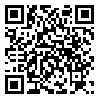BibTeX | RIS | EndNote | Medlars | ProCite | Reference Manager | RefWorks
Send citation to:
URL: http://jdm.tums.ac.ir/article-1-62-en.html
Background and Aims: Lasers with different characteristics have been used to stimulate orthodontic tooth movement. Considering the contradictory findings in this regard, this study was designed to assess the effect of low level laser therapy (LLLT) on the rate of orthodontic tooth movement.
Materials and Methods: In this randomized clinical trial study, 12 patients (4 boys and 8 girls average age:16.9 ± 3.4) with extracted upper first premolars and required canine retraction into extraction site were included. While in both sides canines were retracted by NiTi coil spring, one side was exposed to GaAlAs laser (890 nm). LLLT was done (on the buccal and palatal mucosa by slow movement of probe) at the beginning of the first month. Impression and cast fabrication performed at the beginning of retraction, one and two months later. The amount of retraction on the cast was measured with the aid of a reference plaque fabricated on the rogae using a digital caliper. Data were analyzed using paired sample T-test and one-sample Kolmogorov-Simirnov test.
Results: There was no significant difference in the amounts of canine movement between laser exposed and control sides (P>0.05).
Conclusion: The energy dose of laser used in this study (72 J per each tooth) was not appropriate for increasing dental movement.
Received: 2011/06/9 | Accepted: 2011/10/6 | Published: 2013/09/17
| Rights and Permissions | |
 |
This work is licensed under a Creative Commons Attribution-NonCommercial 4.0 International License. |




